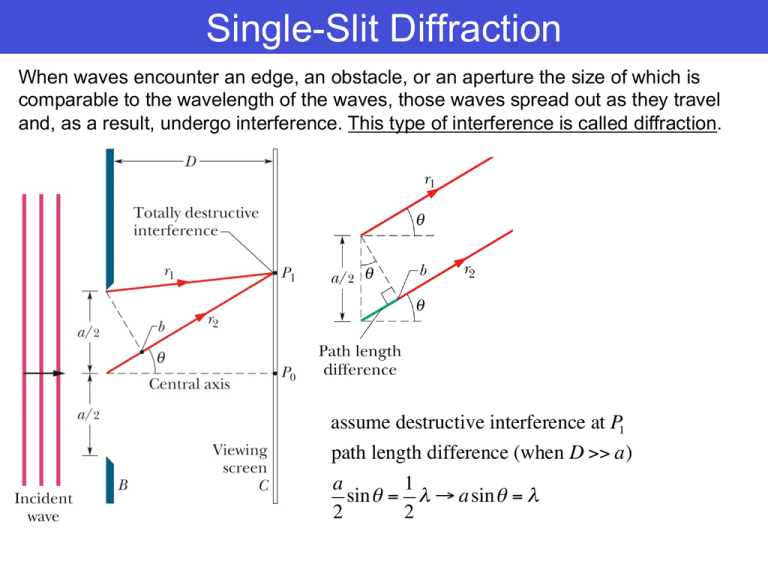Single-Slit Diffraction: Physics Presentation
advertisement

Single-Slit Diffraction When waves encounter an edge, an obstacle, or an aperture the size of which is comparable to the wavelength of the waves, those waves spread out as they travel and, as a result, undergo interference. This type of interference is called diffraction. assume destructive interference at P1 path length difference (when D >> a) a 1 sin θ = λ → asin θ = λ 2 2 Single-Slit Diffraction assume destructive interference at P2 path length difference (when D >> a) a 1 sin θ = λ → asin θ = 2 λ 4 2 all minimum (destructive) locations asin θ = mλ, m = 1, 2, 3,... Intensity in Single-Slit Diffraction The intensity of the diffraction pattern at any given angle θ is ! sin α $ I (θ ) = I m # & " α % 2 where, Im is the intensity at the center of the pattern and πa α= sin θ λ α depends on slit opening a and the wavelength λ of the light. Diffraction by a Circular Aperture Diffraction by a circular aperture or a lens with diameter d produces a central maximum and concentric maxima and minima, given by λ sin θ = 1.22 , first minimum − circular aperture d The angle θ here is the angle from the central axis to any point on that (circular) minimum. Compare: λ sin θ = , first minimum − single slit a which locates the first minimum for a long narrow slit of width a. The main difference is the factor 1.22, which enters because of the circular shape of the aperture. The diffraction pattern of a circular aperture. Note the central maximum and the circular secondary maxima. The figure has been overexposed to bring out these secondary maxima, which are much less intense than the central maximum. Diffraction by a Circular Aperture Resolvability The images of two point sources formed by a converging lens and the corresponding image intensities. Rayleigh’s criterion suggests that two objects are on the verge of resolvability if the central diffraction maximum of one is at the first minimum of the other. Their angular separation can then be no less than θ R = 1.22 λ (Rayleigh's criterion) d in which d is the diameter of the aperture through which the light passes. Diffraction by a Double Slit Waves passing through two slits produce a combination of double-slit interference and diffraction by each slit. The intensity for diffraction by a typical slit of width When the slits width narrows down. The curve above acts as an envelope Diffraction by a Double Slit For identical slits with width a and center-to-center separation d, the intensity in the pattern varies with the angle θ from the central axis as 2 ! sin α $ 2 I (θ ) = I m cos β # & ( double slit ) " α % in which β = πd πa sin θ and α = sin θ λ λ Note carefully that the right side of double slit equation is the product of Im and two factors. 2 (1) The interference factor cos β is due to the interference between two slits with slit 2 ! sin α $ separation d. (2) The diffraction factor # & is due to diffraction by a single slit of width a. " α % Diffraction Gratings A diffraction grating is a series of “slits” used to separate an incident wave into its component wavelengths by separating and displaying their diffraction maxima. Diffraction by N (multiple) slits results in maxima (lines) at angles θ such that d sin θ = mλ, m = 0,1, 2,... (maxima lines) A line’s half-width is the angle from its center to the point where it disappears into the darkness and is given by Δθ hw = λ half width of line at θ Nd cosθ An idealized diffraction grating, consisting of only five rulings, that produces an interference pattern on a distant viewing screen C. Note that for light of a given wavelength λ and a given ruling separation d, the widths of the lines decrease with an increase in the number N of rulings. Thus, of two diffraction gratings, the grating with the larger value of N is better able to distinguish between wavelengths because its diffraction lines are narrower and so produce less overlap. Dispersion and Resolving Power The dispersion D of a diffraction grating is a measure of the angular separation Δθ of the lines it produces for two wavelengths differing by Δλ. For order number m, at angle θ, the dispersion is given by D= Δθ m = dispersion Δλ d cosθ Thus, to achieve higher dispersion we must use a grating of smaller grating spacing d and work in a higher-order m. Note that the dispersion does not depend on the number of rulings N in the grating. The SI unit for D is the degree per meter or the radian per meter. The fine rulings, each 0.5 µm wide, on a compact disc function as a diffraction grating. When a small source of white light illuminates a disc, the diffracted light forms colored “lanes” that are the composite of the diffraction patterns from the rulings. Dispersion and Resolving Power The resolving power R of a diffraction grating is a measure of its ability to make the emission lines of two close wavelengths distinguishable. For two wavelengths differing by Δλ and with an average value of λavg, the resolving power is given by λavg R= = Nm Δλ The intensity patterns for light of two wavelengths sent through the gratings of Table 36-1. Grating B has the highest resolving power, and grating C the highest dispersion. X-Ray Diffraction X rays are electromagnetic radiation whose wavelengths are of the order of 1 Å (=10-10 m). Figure (right) shows that x rays are produced when electrons escaping from a heated filament F are accelerated by a potential difference V and strike a metal target T. (a) The cubic structure of NaCl, showing the sodium and chlorine ions and a unit cell (shaded). (b) Incident x rays undergo diffraction by the structure of (a). The x rays are diffracted as if they were reflected by a family of parallel planes, with angles measured relative to the planes (not relative to a normal as in optics). (c) The path length difference between waves effectively reflected by two adjacent planes is 2dsinθ. (d) A different orientation of the incident x rays relative to the structure. A different family of parallel planes now effectively reflects the x rays. X-Ray Diffraction When x rays are directed toward a crystal structure, they undergo Bragg scattering. The easiest to visualize is when the crystal atoms are considered to be in parallel planes. For x rays of wavelength λ scattering from crystal planes with separation d, the angles θ at which the scattered intensity is maximum are given by 2d sin θ = mλ, m = 1, 2, 3,...

